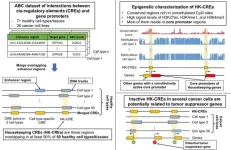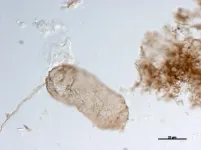(Press-News.org) (Memphis, Tenn.—January 5, 2024) Scientists at St. Jude Children’s Research Hospital are tackling Mycobacterium abscessus (Mab) antibiotic resistance. This naturally antibiotic-resistant pathogen is becoming more prevalent, highlighting the urgent need for novel therapeutics. To address this, the scientists designed new versions of the drug spectinomycin that overcome efflux, the main mechanism driving resistance. The work was published today in Proceedings of the National Academy of Science.
Mab infections are increasingly found in health care settings. Such infections can be hazardous for patients with compromised lung function, such as in cystic fibrosis, or who are immunologically compromised, such as in childhood cancer. These infections are treated with long courses of antibiotics and can result in poor outcomes. The emergence of Mab and other similar pathogens presents a growing and deeply concerning public health threat because there are few effective therapeutic options and a limited drug development pipeline.
“We chemists are in a race against the pathogens. We make stronger antibiotics, and the pathogens become more resistant,” said corresponding author Richard Lee, PhD, St. Jude Department of Chemical Biology and Therapeutics.
Scientists at St. Jude modified the naturally occurring antibiotic spectinomycin to create analogs, comparable but structurally distinct N-ethylene linked aminomethyl spectinomycins (eAmSPCs). These synthetically created eAmSPCs are up to 64 times more potent against Mab than standard spectinomycin.
“By re-engineering the molecule through structure-based drug design, we and our collaborators have adapted the antibiotic to increase its activity,” Lee added.
Overcoming efflux to make a more effective antibiotic
Through their work, the scientists unraveled the mechanism of action by which eAmSPCs are more effective: they circumvent efflux. Efflux is the process that cells use to get rid of a drug — imagine pumping water out of a flooded basement— and is a significant mechanism by which cells become resistant to therapy.
The N-ethylene linkage structure of the eAmSPCs plays a critical role in how the compounds avoid efflux, suggesting that longer linkages modify how the compound is pumped out of the cell. This ultimately shifts the balance toward higher concentrations of eAmSPC within the cell and thus enhances antimicrobial efficacy.
“Over the past two decades, we’ve seen a massive increase in the number of infections caused by non-tuberculous mycobacteria like Mab,” said co-first author Gregory Phelps, PharmD, St. Jude Graduate School of Biomedical Sciences. “We had a place to start with this naturally occurring antibiotic, which, through modification, we’ve made much more efficacious against this clinically relevant pathogen.”
The researchers also found that eAmSPCs work well with various classes of antibiotics used to treat Mab and retain their activity against other mycobacterial strains. Collectively, this work demonstrates that eAmSPCs should be further studied and developed because once issues of tolerability and safety are addressed, these compounds could become next-generation therapeutics.
“It is challenging to attract pharmaceutical companies to develop new antibiotics for several economic reasons,” said Phelps. “If we can boost the drug pipeline against this hard-to-treat bacteria, we can potentially make a difference for patients like the ones we have here at St. Jude who are increasingly faced with limited or no therapeutic options.”
Authors and funding
The study’s co-first author is Martin Cheramie of St. Jude. Other authors include Petra Selchow and Dal Molin, University of Zurich; Michael Meuli, Erik Bottger, and Peter Sander, University of Zurich and National Reference Center for Mycobacteria (Switzerland); Benjamin Killam, Zaid Temrikar, Pradeep Lukka, Bernd Meibohm, and Yury Polikanov, University of Illinois at Chicago; and Dinesh Fernando, Christopher Meyer, Samanthi Waidyarachchi, Suresh Dharuman, Jiuyu Liu, Patricia Murphy, Stephanie Reeve, Laura Wilt, Shelby Anderson, Lei Yang, and Robin Lee, St. Jude.
The study was supported by the National Institutes of Health (R01-AI157312, F31-AI169961, P30-CA021765, R01-GM132302), the Illinois State startup funds, the Swiss National Science Foundation (310030_197699), Swiss Federal Office of Public Health (3632001500), Swiss Joint Program Initiative Antimicrobial Resistance (JPIAMR-ACOMa-2002-050), the University of Zurich, and ALSAC, the fundraising and awareness organization of St. Jude.
If you are interested in licensing this technology from St. Jude (SJ-13-0041 and SJ-18-0007) for further development and/or commercial use find out more about licensing.
St. Jude Media Relations Contacts
Chelsea Bryant
Desk: (901) 595-0564
Cell: (256) 244-2048
chelsea.bryant@stjude.org
media@stjude.org
Rae Lyn Hartley
Cell: (901) 595-4419
RaeLyn.Hartley@stjude.org
media@stjude.org
St. Jude Children's Research Hospital
St. Jude Children's Research Hospital is leading the way the world understands, treats and cures childhood cancer, sickle cell disease and other life-threatening disorders. It is the only National Cancer Institute-designated Comprehensive Cancer Center devoted solely to children. Treatments developed at St. Jude have helped push the overall childhood cancer survival rate from 20% to 80% since the hospital opened more than 60 years ago. St. Jude shares the breakthroughs it makes to help doctors and researchers at local hospitals and cancer centers around the world improve the quality of treatment and care for even more children. To learn more, visit stjude.org, read St. Jude Progress blog, and follow St. Jude on social media at @stjuderesearch.
END
A new approach can address antibiotic resistance to Mycobacterium abscessus
2024-01-05
ELSE PRESS RELEASES FROM THIS DATE:
nTIDE December 2023 Jobs Report: People with disabilities maintain strong employment levels through end of year, staying at historic highs
2024-01-05
East Hanover, NJ – January 5, 2023 – Following a historic high in November, slight declines were seen in the employment-to-population ratio and the labor force participation rate in December 2023 for people with and without disabilities. However, numbers still remain near the record levels achieved the previous month, according to today’s National Trends in Disability Employment – semi-monthly update (nTIDE), issued by Kessler Foundation and the University of New Hampshire’s Institute on Disability (UNH-IOD).
Month-to-Month nTIDE Numbers (comparing November 2023 to December 2023)
Based on data from the U.S. Bureau of Labor Statistics (BLS) Jobs ...
New study reveals crucial 'housekeeping' genetic elements and their potent role to fight cancer
2024-01-05
Technological advancements have enabled scientists to comprehensively explore genetic control elements, unraveling the complexities of gene activation mechanisms in our genetic code. New evidence challenges the simplistic view that cis-regulatory elements (CREs) are mere on/off switches for genes, emphasizing their ability to exhibit complex behaviors, such as the simultaneous enhancement of gene activity and initiation of gene transcription, e.g., simultaneous enhancer and promoter activities. These switches aren't only important for the enhancement ...
Mixed forests protect coastal areas from tsunami impacts better than monoculture forests
2024-01-05
Coastal forests in Japan had predominantly been afforested with black pine (Pinus thunbergii), a shade-tolerant tree species that can withstand dry land ecosystems and harsh coastal environments. This afforestation initiative, dating back to the Edo period (1603~1867), aimed to mitigate the deleterious effects of robust winds and sand blowing. Subsequent to the Great East Japan Earthquake in 2011, interest shifted to the potential protective effects of coastal forests in reducing the destructive power of tsunamis.
The Great East Japan Earthquake tsunami damaged a total of 2,800 hectares (ha; 10,000 square meters) of ...
IDOR participated in a study evaluating selpercatinib for the treatment of non-small cell lung cancer
2024-01-05
D'Or Institute for Research and Education (IDOR) played an important role in the phase III LIBRETTO-431 multicenter study, which evaluated the efficacy and safety of selpercatinib compared to control treatment, which consisted of platinum-based chemotherapy associated or not with pembrolizumab (immune checkpoint inhibitor) in non-small cell lung cancer (NSCLC). The research was published in the New England Journal of Medicine (NEJM), one of the most important scientific publications in the medical field, and included Dr. Milena Perez Mak, IDOR researcher and clinical oncologist at ...
Novel compound protects against infection by virus that causes COVID-19, preliminary studies show
2024-01-05
Compounds that obstruct the "landing gear" of a range of harmful viruses can successfully protect against infection by the virus that causes COVID-19, a study published today and led by Dana-Farber Cancer Institute scientists shows. Based on the findings, researchers have launched a human clinical trial of one such compound made by chemically stabilizing a key coronavirus peptide.
If the compound, called a stapled lipopeptide, proves effective as a nasal spray in the trial, it could be the basis for a new drug modality to prevent or treat COVID-19, say the authors of the study, posted online today in the journal Nature ...
Speech Accessibility Project begins recruiting people with ALS
2024-01-05
The Speech Accessibility Project has expanded its recruitment and is inviting U.S. and Puerto Rican adults living with amyotrophic lateral sclerosis to participate.
Those interested in participating can sign up online.
Funded by Big Tech companies Amazon, Apple, Google, Meta, and Microsoft, the University of Illinois Urbana-Champaign aims to train voice recognition technologies to understand people with diverse speech patterns and disabilities.
The project began recruiting people with Parkinson’s disease last ...
UofL study shows nicotine in e-cigarettes may not be harmless, as some claim
2024-01-05
With the start of a new year, smokers and vapers may have resolved to quit or cut back on the habit to improve their health. They may want to use caution, however, if their strategy involves switching from cigarettes to e-cigarettes, considered by some to be a less harmful alternative.
A new study from the University of Louisville shows the nicotine in certain types of e-cigarettes may be more harmful than others, increasing risk for irregular heartbeat, or heart arrhythmias.
A popular claim is that nicotine in ...
Maternal diabetes and overweight and congenital heart defects in offspring
2024-01-05
About The Study: This study of 620,000 children found that maternal type 1 diabetes was associated with increased risk for most types of congenital heart defects in offspring, while obesity and overweight were associated with increased risk for complex defects and outflow tract obstruction and decreased risk for ventricular septal defects. These different risk profiles of type 1 diabetes and overweight and obesity may suggest distinct underlying teratogenic mechanisms.
Authors: Riitta Turunen, M.D., Ph.D., and Emmi Helle, M.D., ...
Evaluation of changes in prices and purchases following implementation of sugar-sweetened beverage taxes across the US
2024-01-05
About The Study: Sugar-sweetened beverage (SSB) taxes in Boulder, Colorado; Philadelphia, Oakland, San Francisco, and Seattle led to substantial, consistent declines in SSB purchases following price increases associated with those taxes. Scaling SSB taxes nationally could yield substantial public health benefits.
Authors: Scott Kaplan, Ph.D., of the U.S. Naval Academy in Annapolis, Maryland, is the corresponding author.
To access the embargoed study: Visit our For The Media website ...
The evolution of photosynthesis better documented thanks to the discovery of the oldest thylakoids in fossil cyanobacteria
2024-01-05
Researchers at the University of Liège (ULiège) have identified microstructures in fossil cells that are 1.75 billion years old. These structures, called thylakoid membranes, are the oldest ever discovered. They push back the fossil record of thylakoids by 1.2 billion years and provide new information on the evolution of cyanobacteria which played a crucial role in the accumulation of oxygen on the early Earth. This major discovery is presented in the journal Nature.
Catherine Demoulin, Yannick Lara, Alexandre Lambion and Emmanuelle Javaux from the Early Life Traces & Evolution laboratory of the Astrobiology Research ...






